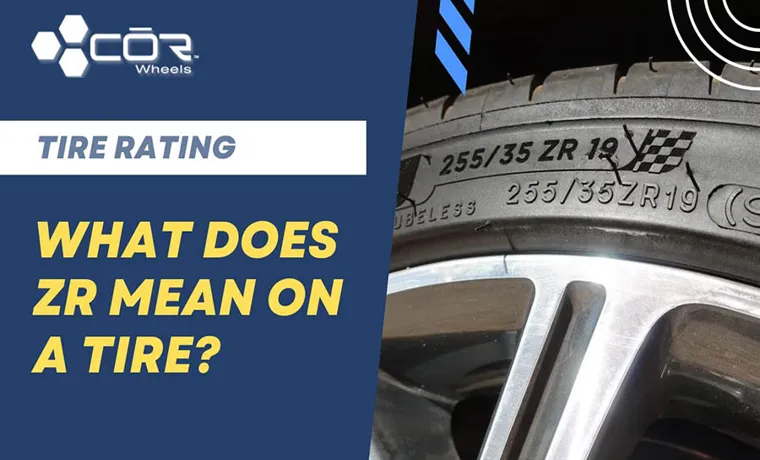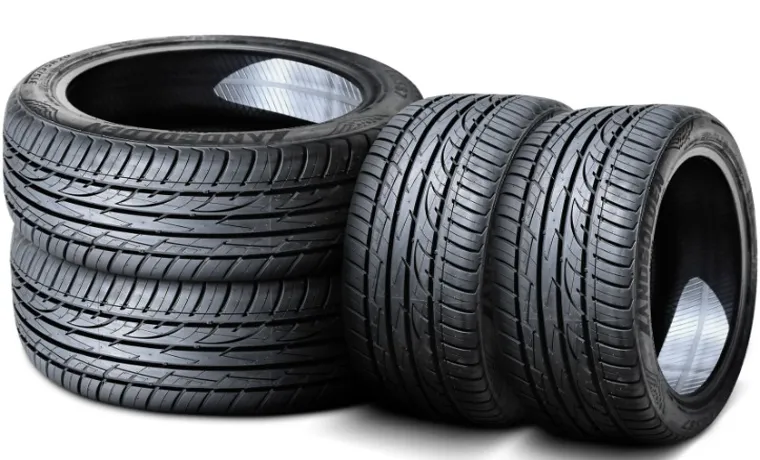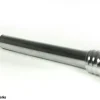If you’ve ever looked closely at your car tires, you may have noticed some seemingly random letters and numbers. One of the most puzzling combinations is “ZR.” What does “ZR” on a tire mean, exactly? Well, fear not, because we’re here to clear up the confusion once and for all! In short, ZR simply indicates that the tire is rated for high-speed performance.
But there’s much more to it than that. In this blog, we’ll delve into the details of what ZR means, how it affects your driving experience, and why you should consider it when choosing tires for your vehicle. So buckle up and get ready for a wild ride!
Table of Contents
Understanding Tire Markings
If you’ve ever looked at the sidewall of a tire, you may have noticed a series of letters and numbers. These markings can provide information about the tire’s size, load capacity, and speed rating. One of the most perplexing markings you might come across is “ZR.
” This stands for “Z-speed rating,” indicating that the tire is rated for speeds of 149 mph or higher. However, it’s important to note that not all tires with a “Z” in the speed rating will have a “ZR” marking. In fact, the presence or absence of this marking is not considered a reliable indicator of a tire’s performance capabilities.
To ensure your safety on the road, it’s always best to consult the manufacturer’s recommendations for your particular vehicle. While tire markings can seem confusing, a little research can go a long way in helping you understand what they mean and make informed choices about your vehicle’s tires.
Tire Speed Ratings
Tire speed ratings can be confusing for the average person when you are confronted with markings on your tires. These ratings are represented by letters that are found on your tire’s sidewall, indicating the maximum speed your tire can sustain without any damage or risk. The most common speed rating found on tires is the letter “H”, meaning the tire can safely travel at speeds up to 130 miles per hour, while “V” rated tires can sustain speeds up to 149 mph.
It is important to note that speed ratings should never be ignored, as ignoring them can risk the safety of you and your passengers. Even if you never drive at such high speeds, it is still important to have tires with an adequate speed rating to maintain the safety and integrity of your vehicle. When selecting new tires, always consult your vehicle’s owner manual to ensure you choose the appropriate speed rating for your driving needs.

Load Index Ratings
When shopping for new tires, you might notice markings on the sidewall that can be confusing. One of these markings is the load index rating, which is an important factor to consider when choosing tires. The load index is a numerical code that indicates the maximum weight that a tire can carry when inflated to its recommended pressure.
The higher the number, the greater the weight capacity of the tire. For example, a tire with a load index of 92 can carry up to 1389 pounds, while a tire with a load index of 109 can carry up to 2271 pounds. It’s important to choose tires with a load index rating that matches the weight of your vehicle and any additional weight that might be carried, such as passengers or cargo.
By understanding tire markings like the load index rating, you can make an informed decision when choosing the right tires for your vehicle.
Decoding the ZR Marking
Have you ever seen the letters “ZR” on the side of a tire and wondered what they mean? It’s actually a code that indicates the tire is designed for high-speed performance. The “Z” signifies that the tire is rated for speeds over 149 mph. The “R” indicates that it’s a radial tire, which is the most common type of tire these days.
So, in short, if you see the letters “ZR” on a tire, you can expect it to be a high-performance tire designed for speeds over 149 mph. It’s important to note that not all tires with the ZR marking are created equal, so it’s always wise to consult with a professional to determine the best tire for your specific vehicle and needs.
The Letter ‘Z’
If you’ve ever come across a tire with the marking “ZR,” you might be wondering what it means. Well, the “Z” actually denotes the tire’s speed rating, with Z being the highest rating possible for tires that can go over 149 mph! The “R,” on the other hand, simply indicates that it’s a radial tire (as opposed to a bias-ply, or cross-ply tire). So next time you see the “ZR” marking on a tire, you can be confident that it’s capable of high-speed performance.
Just remember to always drive safely and responsibly on the roads!
The Letter ‘R’
If you’re a gun enthusiast, you may have come across the ZR marking on your firearm and wondered what it means. The answer lies in the letter “R” – more specifically, the absence of it. The ZR marking is short for “ZR1”, which stands for “Zone Restricted – 1”.
This is a classification used by the United States military to designate firearms that are restricted to certain areas or zones. The absence of the letter “R” in the ZR1 marking signifies that the firearm is not rated for full automatic fire. So, if you see the ZR marking on your firearm, rest assured that it is still a fully functional weapon, just with certain restrictions in place.
Benefits of ZR Tires
If you’re a car enthusiast, you might have heard the term “ZR” when shopping for tires. But what does ZR mean on tire? Simply put, the letter “Z” signifies the tire’s speed rating, indicating that it’s rated for speeds above 149 mph. Meanwhile, the letter “R” means that it’s a radial tire.
When it comes to the benefits of ZR tires, there are a few things to consider. For starters, ZR tires are designed to provide superior handling and performance, thanks to their specialized construction and high-speed rating. Additionally, ZR tires typically have a stiffer sidewall, which helps to prevent the tire from flexing too much under high speed or heavy load conditions.
Overall, ZR tires are a great choice for drivers looking for a high-performance tire that can handle fast speeds and provide a smooth, comfortable ride. Just be sure to check the specific speed rating for your tire, as there are different types of ZR tires available for different vehicles and driving conditions. With the right ZR tire, you can enjoy the thrill of driving at high speeds without sacrificing safety or performance.
Enhanced Performance and Handling
ZR tires are the ultimate upgrade for any car enthusiast looking for enhanced performance and handling. These tires offer a multitude of benefits that are hard to resist. Firstly, they provide outstanding grip on the road, offering exceptional traction and stability, especially on high-speed corners and winding roads.
Secondly, the advanced construction of ZR tires allows them to handle higher temperatures, resulting in better wear resistance and durability. Moreover, they’re designed to reduce rolling resistance, which means less energy is required to maintain speed and acceleration, leading to improved fuel efficiency. Additionally, ZR tires offer improved steering response, providing a more precise and direct feel, making them perfect for driving in any condition.
Whether you’re cruising on the highway or racing on the track, ZR tires are sure to give you the performance you crave. So, if you’re looking to take your car’s performance to the next level, ZR tires are unquestionably the way to go!
Improved Traction and Stability
ZR tires offer a range of benefits, including improved traction and stability for drivers. This is because the ZR tire has a wider contact patch than conventional tires, which gives it more grip on the road. This makes it easier to accelerate and brake, especially in wet or slick conditions.
In addition, the ZR tire has a stiffer sidewall, which helps it maintain its shape under hard cornering. This means that drivers can take corners at higher speeds without losing control. The ZR tire’s tread pattern also helps to improve traction and stability, as it is designed to channel water away from the tire’s surface, reducing the risk of hydroplaning and improving grip.
Overall, ZR tires are an excellent choice for drivers who are looking for better performance and handling on the road.
Conclusion
In conclusion, the mysterious code “ZR” on a tire does not actually stand for anything specific. It is simply a symbol used to indicate the tire’s speed rating. So, when you’re cruising down the highway with your ZR-rated tires, you can rest assured that they are designed and tested to handle high speeds with ease.
So, put the pedal to the metal and enjoy the ride! Just be sure to stay within the legal speed limit, of course.
FAQs
What is the significance of “ZR” in a tire’s rating?
The “ZR” rating on a tire indicates that it is a performance tire with a high-speed capability of over 149 mph.
Can I use a ZR-rated tire on my regular passenger car?
Yes, you can use a ZR-rated tire on a regular passenger car, but it may not be necessary unless you frequently drive at high speeds.
What is the difference between a ZR-rated tire and an H-rated tire?
A ZR-rated tire has a higher speed rating than an H-rated tire, and it is designed for high-performance vehicles that require exceptional handling.
How does the ZR rating affect the tire’s durability?
The ZR rating does not necessarily affect the tire’s durability, but high-performance tires may wear out faster due to their softer compound.
What other tire ratings should I consider besides the ZR rating?
Other tire ratings to consider include load capacity, tread life, wet and dry traction, and fuel efficiency.
Do ZR-rated tires cost more than other tires?
Yes, ZR-rated tires tend to be more expensive than lower-rated tires due to their specialized design and materials.
Can I mix ZR-rated tires with other rating types on my vehicle?
It is not recommended to mix ZR-rated tires with other rating types, as it may affect the handling and performance of the vehicle.



